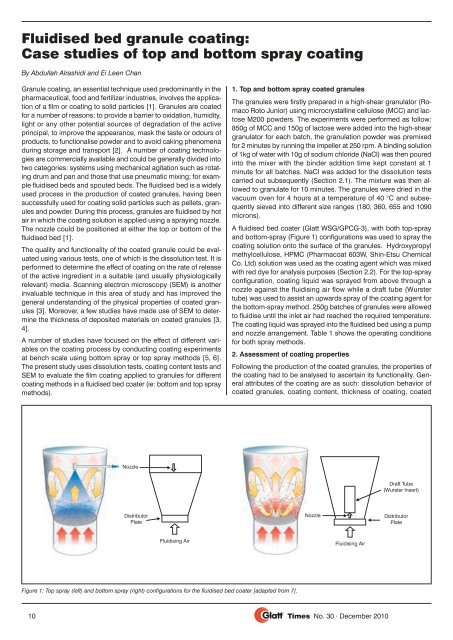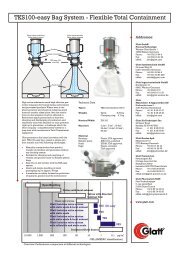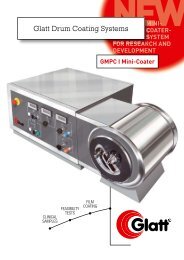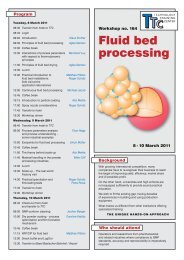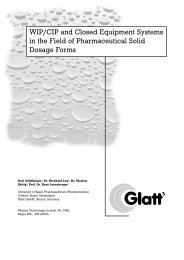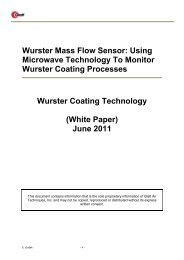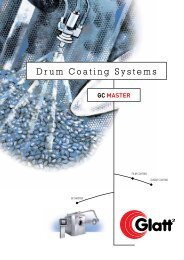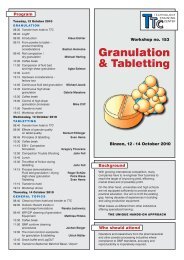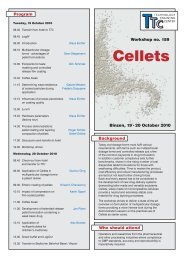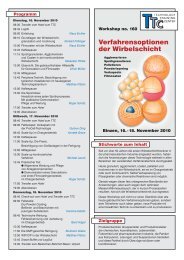No. 30 - Glatt
No. 30 - Glatt
No. 30 - Glatt
You also want an ePaper? Increase the reach of your titles
YUMPU automatically turns print PDFs into web optimized ePapers that Google loves.
Fluidised bed granule coating:<br />
Case studies of top and bottom spray coating<br />
By Abdullah Alrashidi and Ei Leen Chan<br />
Granule coating, an essential technique used predominantly in the<br />
pharmaceutical, food and fertilizer industries, involves the application<br />
of a film or coating to solid particles [1]. Granules are coated<br />
for a number of reasons: to provide a barrier to oxidation, humidity,<br />
light or any other potential sources of degradation of the active<br />
principal, to improve the appearance, mask the taste or odours of<br />
products, to functionalise powder and to avoid caking phenomena<br />
during storage and transport [2]. A number of coating technologies<br />
are commercially available and could be generally divided into<br />
two categories: systems using mechanical agitation such as rotating<br />
drum and pan and those that use pneumatic mixing; for example<br />
fluidised beds and spouted beds. The fluidised bed is a widely<br />
used process in the production of coated granules, having been<br />
successfully used for coating solid particles such as pellets, granules<br />
and powder. During this process, granules are fluidised by hot<br />
air in which the coating solution is applied using a spraying nozzle.<br />
The nozzle could be positioned at either the top or bottom of the<br />
fluidised bed [1].<br />
The quality and functionality of the coated granule could be evaluated<br />
using various tests, one of which is the dissolution test. It is<br />
performed to determine the effect of coating on the rate of release<br />
of the active ingredient in a suitable (and usually physiologically<br />
relevant) media. Scanning electron microscopy (SEM) is another<br />
invaluable technique in this area of study and has improved the<br />
general understanding of the physical properties of coated granules<br />
[3]. Moreover, a few studies have made use of SEM to determine<br />
the thickness of deposited materials on coated granules [3,<br />
4].<br />
A number of studies have focused on the effect of different variables<br />
on the coating process by conducting coating experiments<br />
at bench scale using bottom spray or top spray methods [5, 6].<br />
The present study uses dissolution tests, coating content tests and<br />
SEM to evaluate the film coating applied to granules for different<br />
coating methods in a fluidised bed coater (ie: bottom and top spray<br />
methods).<br />
Figure 1: Top spray (left) and bottom spray (right) configurations for the fluidised bed coater [adapted from 7].<br />
10<br />
<strong>No</strong>zzle<br />
Distributor<br />
Plate<br />
Fluidising Air<br />
1. Top and bottom spray coated granules<br />
The granules were firstly prepared in a high-shear granulator (Romaco<br />
Roto Junior) using microcrystalline cellulose (MCC) and lactose<br />
M200 powders. The experiments were performed as follow:<br />
850g of MCC and 150g of lactose were added into the high-shear<br />
granulator for each batch, the granulation powder was premixed<br />
for 2 minutes by running the impeller at 250 rpm. A binding solution<br />
of 1kg of water with 10g of sodium chloride (NaCl) was then poured<br />
into the mixer with the binder addition time kept constant at 1<br />
minute for all batches. NaCl was added for the dissolution tests<br />
carried out subsequently (Section 2.1). The mixture was then allowed<br />
to granulate for 10 minutes. The granules were dried in the<br />
vacuum oven for 4 hours at a temperature of 40 °C and subsequently<br />
sieved into different size ranges (180, 360, 655 and 1090<br />
microns).<br />
A fluidised bed coater (<strong>Glatt</strong> WSG/GPCG-3), with both top-spray<br />
and bottom-spray (Figure 1) configurations was used to spray the<br />
coating solution onto the surface of the granules. Hydroxypropyl<br />
methylcellulose, HPMC (Pharmacoat 603W, Shin-Etsu Chemical<br />
Co. Ltd) solution was used as the coating agent which was mixed<br />
with red dye for analysis purposes (Section 2.2). For the top-spray<br />
configuration, coating liquid was sprayed from above through a<br />
nozzle against the fluidising air flow while a draft tube (Wurster<br />
tube) was used to assist an upwards spray of the coating agent for<br />
the bottom-spray method. 250g batches of granules were allowed<br />
to fluidise until the inlet air had reached the required temperature.<br />
The coating liquid was sprayed into the fluidised bed using a pump<br />
and nozzle arrangement. Table 1 shows the operating conditions<br />
for both spray methods.<br />
2. Assessment of coating properties<br />
Following the production of the coated granules, the properties of<br />
the coating had to be analysed to ascertain its functionality. General<br />
attributes of the coating are as such: dissolution behavior of<br />
coated granules, coating content, thickness of coating, coated<br />
<strong>No</strong>zzle<br />
Fluidising Air<br />
Times <strong>No</strong>. <strong>30</strong> · December 2010<br />
Draft Tube<br />
(Wurster Insert)<br />
Distributor<br />
Plate


